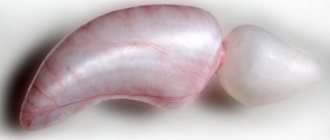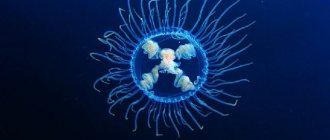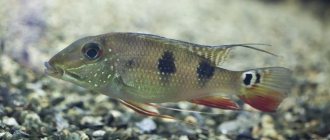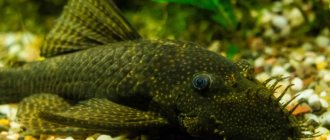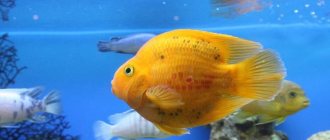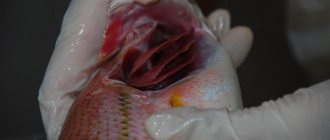Structure and development
Most fish have a characteristic pouch-like structure between the intestines and kidneys. This structure is called by various names, namely: swim bladder (gas or air bladder in fish). The connection to the esophagus (outgrowth) may remain throughout life, but may be lost in adulthood.
The fish bladder occupies the same position as the lungs of higher vertebrates, and is therefore considered homologous to the lungs. It differs from the higher lung forms mainly in origin and blood supply. It arises from the dorsal wall of the intestine, receives its blood supply, as a rule, from the dorsal aorta, the vertebral lung - from the ventral wall of the pharynx, receives blood from the sixth aortic arch.
A swim bladder is a gas-filled sac located above the intestines of a fish. The acquisition of the bladder, with the neutral buoyancy it gives to its owners, was one of the decisive steps in the evolution of modern fish. Without it, fish would undoubtedly be much less diverse - in terms of number of species, habitat - than they are today. Modern sharks and rays live without it, so they must either continue to move all day or live on the seabed. This is because fish are heavier than water, hence they will drown if they stop swimming.
Gas filling of the bladder
In physostome fish, gas is displaced from the swim bladder through a pneumatic canal, but in physoclist fish, where there is no pneumatic canal, excess gas is removed by diffusion.
External structure of bony fish
The body of a perch consists of three sections:
- head,
- torso,
- tail.
Conventionally, the boundary between the head and the body is considered to be the back part of the gill covers, and between the body and the tail is the anus.
Basically, the body of the fish is elongated and streamlined. It is covered with tiled-like bone scales, the concentric rings of which can be used to determine the age of the animal. The scales enter the skin at one end.
Are you an expert in this subject area? We invite you to become the author of the Directory Working Conditions
The skin glands secrete mucus, which helps reduce friction with water and performs a protective function.
Fins play a significant role in the swimming of fish:
- the main role in forward movement belongs to the caudal fin (unpaired equal-lobed fin);
- dorsal and anal (also unpaired fins) act as stabilizers;
- paired fins (pectoral and ventral) are necessary for turning, stopping, and maintaining balance.
What role does the swim bladder play in fish?
It acts as an adjustable float so that the fish can swim at any depth with the least amount of effort. As the fish sinks to the bottom, the specific gravity of the body increases. When it rises, the swim bladder expands and the specific gravity decreases. With this adjustment, the fish can maintain balance at any level.
Hydrostatic function
This is, first of all, a hydrostatic apparatus that is needed and helps to maintain body weight equal to the volume of water displaced by the fish. It also serves to balance the body with respect to its environment by increasing or decreasing the gas content.
Swim bladders can be filled with either air or oxygen, which plays a key role in maintaining neutral buoyancy and reducing the energy expenditure of fish to stay at any given depth.
Protective function
The respiratory function of the swim bladder is very significant. In water with low oxygen content, in many fish, oxygen produced in the bladder serves as a source of oxygen rather than absorbing air through the mouth from the atmosphere. In some fish, the swim bladder is modified into a “lung” capable of receiving atmospheric air. For example, multi-feathered polypterus have a double breathing system - gill and pulmonary.
Functions of the senses
It is believed that the swim bladder is designed to function as a resonator (but not in cartilaginous fish). It amplifies sound vibrations and transmits them to the ear. In many fish it is closely connected with the inner ear. This connection may allow pressure changes to be transmitted to the perilymph.
It helps fish produce sound. Vibrations are caused by the movement of air contained in the fish's bladder. Sound can also be produced by contraction of the external and internal muscles of the swim bladder.
Other features
The fish's bladder helps maintain a proper center of gravity by moving gas from one part to another, making it easier to exhibit various movements.
The oldest fish
Coelacanth
In 1939, fishermen caught a fish in the Comoros area that created a sensation in the scientific world. The fish was named “coelacanth” after the curator of the museum, Courtenay Latimer, who handed it over to zoologists for study. Coelacanth belongs to the order of lobe-finned fishes, from which the first land vertebrates originated. The fossilized remains of such fish were known to scientists, but it was believed that the fish themselves became extinct 70-80 million years ago. It turned out that the “living fossil” still lives in the deep-sea regions of the Indian Ocean.
Share link
Swim bladder and lungs in different groups
Almost all bony fish have a swim bladder and usually function as a hydrostatic organ. Beginning as a very minor cellular extension from the intestines, the bladder in fish leads the entire group along an evolutionary channel.
What fish don't have a bladder?
It is absent in adult sharks, but a hint of a vestigial vesicle is observed during embryonic development. But almost all teleosts have it. As a result of adaptation to different ways of life, extreme modifications occur.
Place of fish in the animal world
In the modern classification system, fish occupy the following places: animal kingdom, multicellular subkingdom, chordate type, vertebrate subtype (jawed), superclass fish. Fish are divided into two large classes:
- Class cartilaginous.
The skeleton is cartilaginous, the gill slits open outward, there is no swim bladder. This includes the Sharks, Rays, and Chimeras squads. - Bone class.
The skeleton is made of bone tissue, the gill slits are covered with covers, and most have a swim bladder. These include the orders Sturgeons, Cyprinids, Herrings, and Cods.
Next - families, genera, species - more than 25,000 species of animals, which we speak of with respect: the oldest chordates on Earth.
Rice. 1. Classification of fish
Causes of the disease
This disorder is sometimes caused by compression due to a bloated stomach from eating quickly, overeating, constipation, or swallowing air, which is thought to occur with floating food.
Eating freeze-dried or dry flake foods that expand when moistened may also cause an enlarged stomach or intestinal tract.
The swim bladder is an organ that helps the fish maintain balance and an upright swimming position. When the bladder becomes too full or blocked, or the fish becomes infected, it swims on its side. But you don't have to lose hope right away. It could be a simple case of illness. If you catch it early enough, there is a chance that your fish will be able to recover with time and proper treatment.
Unfortunately, goldfish commonly suffer from swim bladder disorder.
Genetics appears to play a role, as the goldfish's shape is thought to make it a prime candidate for the disorder. Their short, round bodies can sometimes cause organs to become compressed (especially when overeating or constipated), which can cause the swim bladder to malfunction. It may be noted that longer breeds of goldfish (those with larger bodies) tend to be less susceptible to this disorder.
Koi are also prone to swim bladder disorders. Due to their larger size, special considerations must be taken when attempting to x-ray Koi. The size and shape of the swim bladder may gradually change over time to compensate for decreased mobility. These changes, which may become permanent, will allow koi with less mobility to survive in their home environment.
Fish superclass
- Integument, musculoskeletal system
- Digestive system
- Respiratory system
- Circulatory system
- Excretory system
- Nervous system
- Reproductive system
The body shape is streamlined, fish-shaped, thereby reducing friction with the water. The surface of the body is covered with overlapping scales (like tiles).
In most species, the scales are ctenoid (from the Greek ktéis - ridge and éidos - view) - equipped with teeth or spines, or cycloid (from the Greek kykloeides - circular, round) - with a smooth rounded rear edge.
The skin contains many glands that secrete mucus that covers the entire body of the fish, thereby reducing friction with the water. Because of the mucus, it is difficult to hold the caught fish in your hands; it slips out.
Fins are the organs of movement of fish. Fins can be either paired (pectoral, ventral) or unpaired (dorsal, caudal, anal).
The skull is the seat of the brain and surrounds it on all sides. Characteristic is the presence of a rostrum (from Latin rostrum - beak) - the front elongated part of the fish skull.
The spine consists of two sections: trunk and caudal. There is a hole in the center of each vertebra. Adjacent to each other, the openings of the vertebrae are connected together into a single spinal canal, in which the spinal cord lies.
The skeleton of the pectoral fins is connected to the spine by the bones of the pectoral girdle, in contrast to the skeleton of the pelvic fins, which is not articulated with the spine. There are gill covers that cover the gill slits from the outside (in cartilaginous fish there were no gill covers; 5 gill slits each opened separately to the outside.)
The body cavity is secondary (coelom).
The muscular system is segmented, which is expressed in the appearance of separate (differentiated) muscle bundles. The most striking example of differentiation is the muscles of the oral apparatus and paired fins.
Consists of the oral cavity, pharynx, which continues into the esophagus, stomach, large and small intestines. Many fish have a tongue and sharp teeth located on the jaws in their mouths. Teeth are not designed for mechanical grinding of food, but mainly for grasping and holding prey. There are no salivary glands, but there are taste buds.
The ducts of the digestive glands, liver and pancreas, as well as the gall bladder open into the lumen of the small intestine of fish. There is no spiral valve in the intestine (characteristic of cartilaginous fish), the total absorption area is increased due to blindly ending intestinal outgrowths - pyloric appendages.
The pharynx is closely connected not only with the digestive system, but also with the respiratory system: the gill apparatus of fish is located here. With the help of gills, they have adapted to take oxygen dissolved in it from the water and saturate the blood with it, from where oxygen is supplied to the internal organs and tissues.
The breathing process is carried out due to the fact that water enters the pharynx through the mouth. Due to the movements of the operculum, water from the oropharyngeal cavity is drawn into the lateral gill cavity, washing the gills. As a result of gas exchange, oxygen enters the blood of the fish, and carbon dioxide leaves it and dissolves in the water.
The gills consist of a gill arch on which the gill rakers and petals are located. The gill rakers are directed towards the oropharyngeal cavity and prevent the penetration of food particles into the gills (filtration function). The gill filaments are directed outward and are intertwined with a dense network of blood vessels - capillaries, in which gas exchange occurs.
Like cartilaginous fish, bony fish have one circulation. The heart is two-chambered, consisting of one atrium and one ventricle. Remember that fish have venous blood in their hearts. It is pumped by the heart into the gills, where it is saturated with oxygen, after which the blood becomes arterial.
Arterial blood is directed to internal organs and tissues, blood moves inside the vessels: a closed circulatory system.
It consists of paired ribbon-shaped trunk kidneys (mesonephros, or primary kidney.) They are located on the sides of the body. The ureters begin from the kidneys, merging with each other and forming an extension - the bladder.
Urine containing metabolic by-products is excreted from the fish’s body through the anus in females and through the genitourinary opening in males.
All chordates have a tubular nervous system. The brain consists of the medulla oblongata, midbrain, cerebellum, diencephalon and forebrain.
The development of the same sections in different classes of chordates is not the same, which we will clearly see as we study this section. I recommend that you pay special attention to this topic.
Compared to other classes of chordates, the brain of fish is poorly developed: the forebrain cortex is absent, instead the surface of the brain is covered with epithelium. The midbrain, the main coordinating center, reaches its greatest development.
The cerebellum, which is responsible for coordination of movements and orientation of the body in space, is also well expressed (developed). This is due to the complex movements of the fish, which “soars like a bird” only not in the air, but in the aquatic environment. 10 pairs of cranial nerves originate from the brain.
The sensory organs of a fish are represented by a special formation - a lateral line, stretching in the form of a channel along the entire body on both sides. Sensitive cells (neuromasts) of the lateral line organ respond to changes in the direction and speed of water flow near the fish. With its help, the fish senses the direction and speed of the water flow.
In fish, a specialized hearing organ—the inner ear—appears for the first time. With its help, they are able to distinguish sounds while navigating in the aquatic environment. The inner ear consists of three semicircular canals, the upper and lower saccules. Sometimes the inner ear is connected to the swim bladder (catfish, carp), due to which the hearing in such fish is more developed.
The organs of vision are adapted to the aquatic environment: the lens has a spherical shape. The cornea is flat, accommodation (adjusting the eye to the best vision of an object) occurs only due to the movement of the lens.
Fish see well only at close range. There are taste organs on the skin and lower jaw, as well as olfactory organs that open into the oral cavity.
Fish are dioecious. The gonads of males are testes, of females - a single ovary. Fertilization is external and occurs in water: the female lays eggs (eggs), and the male releases sperm into the water, which merge with the eggs. Over time, young individuals develop from eggs.
Development in most fish (teleosts) is indirect, with metamorphosis. Remember that the process of laying eggs and their subsequent fertilization is called spawning, it is seasonal. Freshwater fish spawn in the spring; fishing is strictly prohibited at this time.
Evolution
The swim bladder has much in common with the lungs: it also develops from an outgrowth of the digestive tract and has approximately the same innervation and muscular environment. However, the question of the homology of the swim bladder and lungs is not entirely clear. The main differences between these organs are as follows: (1) the swim bladder is usually located on the dorsal side of the digestive tract, and the lungs on the abdominal side; (2) the swim bladder is unpaired, and the lungs are usually paired; (3) blood coming from the lungs enters the heart separately from the rest of the bloodstream, and blood coming from the swim bladder along with blood from other organs.
Judging by the prevalence of the swim bladder and lungs in different groups of animals, the common ancestor of bony fish had lungs (as paired derivatives of the abdominal wall of the digestive tract). Perhaps they arose as an organ of additional respiration under conditions of periodic lack of oxygen in water. Among modern fish, the respiratory function of the lungs or swim bladder was preserved mainly by those living precisely in such conditions. The primacy of the respiratory function of these organs is also indicated by the fact that in order to effectively perform the function of a float, they must already be quite large (about 7% of the body volume). However, respiratory and hydrostatic functions are not mutually exclusive. The swim bladder of bony fishes is a later acquisition than the lungs. It could have originated from them or arisen independently.
